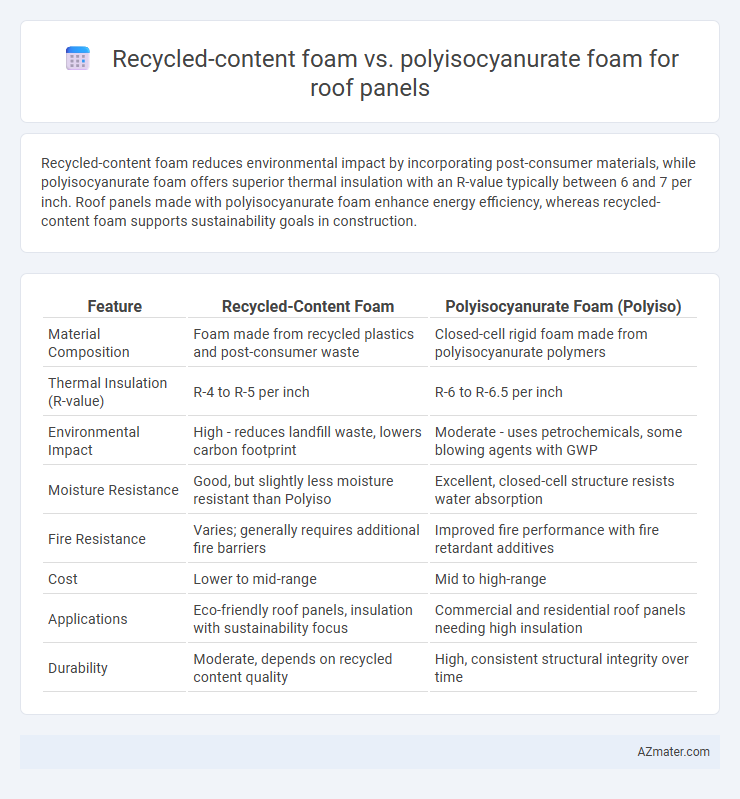Recycled-content foam reduces environmental impact by incorporating post-consumer materials, while polyisocyanurate foam offers superior thermal insulation with an R-value typically between 6 and 7 per inch. Roof panels made with polyisocyanurate foam enhance energy efficiency, whereas recycled-content foam supports sustainability goals in construction.
Table of Comparison
| Feature | Recycled-Content Foam | Polyisocyanurate Foam (Polyiso) |
|---|---|---|
| Material Composition | Foam made from recycled plastics and post-consumer waste | Closed-cell rigid foam made from polyisocyanurate polymers |
| Thermal Insulation (R-value) | R-4 to R-5 per inch | R-6 to R-6.5 per inch |
| Environmental Impact | High - reduces landfill waste, lowers carbon footprint | Moderate - uses petrochemicals, some blowing agents with GWP |
| Moisture Resistance | Good, but slightly less moisture resistant than Polyiso | Excellent, closed-cell structure resists water absorption |
| Fire Resistance | Varies; generally requires additional fire barriers | Improved fire performance with fire retardant additives |
| Cost | Lower to mid-range | Mid to high-range |
| Applications | Eco-friendly roof panels, insulation with sustainability focus | Commercial and residential roof panels needing high insulation |
| Durability | Moderate, depends on recycled content quality | High, consistent structural integrity over time |
Introduction to Roofing Insulation Materials
Recycled-content foam offers an environmentally friendly roofing insulation option by utilizing post-consumer and industrial waste, reducing landfill impact and conserving resources. Polyisocyanurate foam, known for its high R-value per inch, provides superior thermal resistance and fire-retardant properties, making it a popular choice for commercial and residential roof panels. Both materials contribute to energy efficiency, but recycled-content foam emphasizes sustainability while polyisocyanurate prioritizes insulation performance and durability.
What is Recycled-Content Foam?
Recycled-content foam for roof panels consists of materials derived from pre-consumer or post-consumer recycled plastics and foam scraps, reducing environmental impact by diverting waste from landfills. This foam offers thermal insulation comparable to traditional polyisocyanurate foam but with a lower carbon footprint due to its sustainable manufacturing process. Incorporating recycled-content foam in roof panels supports green building certifications such as LEED and contributes to energy-efficient roofing systems.
Overview of Polyisocyanurate Foam
Polyisocyanurate foam, commonly known as polyiso, is a high-performance rigid insulation material used in roof panels, prized for its superior thermal resistance with an R-value typically ranging from 6 to 7 per inch. Unlike recycled-content foam, polyiso offers enhanced fire resistance and dimensional stability, making it ideal for commercial roofing applications requiring long-term durability and energy efficiency. Its closed-cell structure minimizes moisture absorption, contributing to the extended lifespan and reduced thermal bridging in insulated roof assemblies.
Environmental Impact: Recycled versus Polyiso Foam
Recycled-content foam in roof panels significantly reduces environmental impact by diverting waste from landfills and lowering the demand for virgin raw materials, thus decreasing carbon emissions associated with production. Polyisocyanurate (Polyiso) foam, although highly efficient in thermal insulation, typically relies on petrochemical resources and generates higher embodied energy during manufacturing. Choosing recycled-content foam enhances sustainability in roofing by promoting circular economy principles and minimizing the overall carbon footprint of building materials.
Thermal Performance Comparison
Recycled-content foam and polyisocyanurate foam both offer efficient thermal insulation for roof panels, with polyisocyanurate typically providing higher R-values per inch, often ranging between R-6.0 and R-6.5 compared to recycled-content foam's R-values around R-4.0 to R-5.0. Polyisocyanurate foam has superior thermal resistance and performs better at elevated temperatures, maintaining its insulating properties longer under heat stress. Recycled-content foam, while environmentally advantageous, may have slightly lower thermal performance, but still offers effective insulation for sustainable roofing applications.
Durability and Longevity Analysis
Recycled-content foam and polyisocyanurate foam both offer durable insulation solutions for roof panels, but polyisocyanurate foam typically provides superior longevity due to its high thermal resistance and moisture resistance, which helps maintain structural integrity over time. Recycled-content foam's durability can vary depending on the specific blend and density, often resulting in lower R-values and potential susceptibility to moisture-related degradation compared to polyisocyanurate foam. For long-term roof panel performance, polyisocyanurate foam is preferred for its consistent durability, resistance to thermal drift, and extended lifespan under harsh environmental conditions.
Moisture Resistance in Roof Panels
Polyisocyanurate foam offers superior moisture resistance compared to recycled-content foam, making it a more effective barrier against water infiltration in roof panels. Recycled-content foam tends to absorb more moisture, potentially reducing insulation effectiveness and increasing the risk of mold growth. The higher closed-cell structure of polyisocyanurate foam enhances durability and maintains thermal performance under humid conditions.
Cost Factors and Economic Considerations
Recycled-content foam generally offers lower material costs and improved environmental benefits compared to polyisocyanurate foam, making it an attractive option for budget-conscious roofing projects. Polyisocyanurate foam, while typically more expensive upfront, provides superior thermal insulation and longer lifespan, which can result in greater energy savings and reduced maintenance expenses over time. Evaluating the total cost of ownership, including installation, energy efficiency, and durability, is crucial for making the most economic choice between these roof panel materials.
Installation and Handling Differences
Recycled-content foam offers easier cutting and shaping during installation due to its flexible composition, reducing on-site waste and labor time compared to polyisocyanurate foam, which is more rigid and requires specialized tools for precise fitting. Polyisocyanurate foam panels are lighter and have higher dimensional stability, facilitating quicker placement but demand careful handling to avoid edge damage and maintain thermal performance. Installation of recycled-content foam tends to be more forgiving in varying weather conditions, while polyisocyanurate foam requires dry environments to prevent moisture-related degradation during handling.
Choosing the Right Foam for Sustainable Roofing
Recycled-content foam integrates post-consumer materials, reducing landfill waste and lowering the overall carbon footprint of roof panels, making it a sustainable option. Polyisocyanurate foam offers superior thermal insulation with high R-values, enhancing energy efficiency in roofing systems. Selecting between these foams depends on balancing environmental impact with insulation performance to achieve optimal sustainability in roofing projects.

Infographic: Recycled-content foam vs Polyisocyanurate foam for Roof panel
 azmater.com
azmater.com